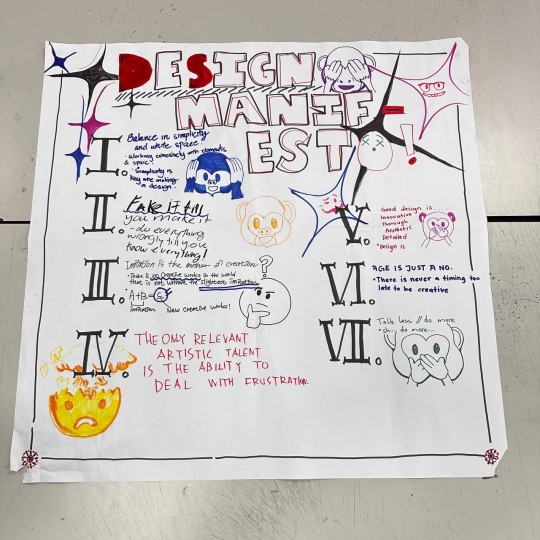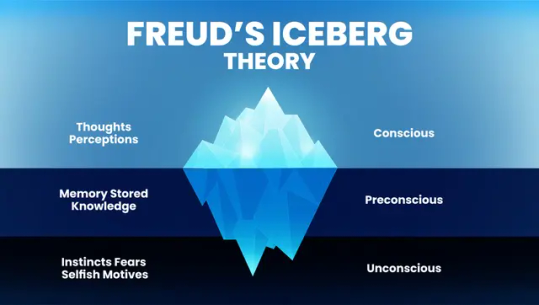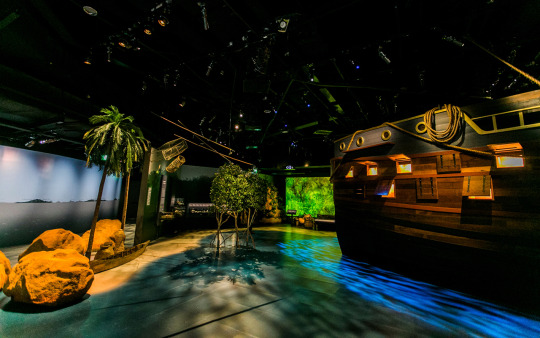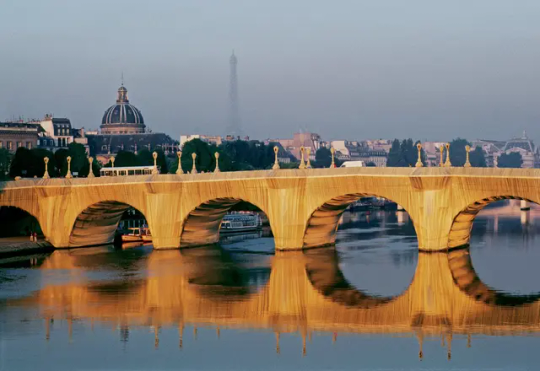Don't wanna be here? Send us removal request.
Text

Compulsory Question 2 - Restate your artistic vision statement, and revise it if necessary.
Select one work of design under the theme of social engagement (W3) or tradition/ lineages (W4 & 5). Discuss this choice in connection with your own aspirations and the themes of CTS B. Start by revisiting your artistic vision statement. Is it well thought out?��Based on your classmate’s comments, do you think it needs to be revised? Select at least one work of design that really resonates with you, that connects with your vision statement. List down the reasons for your choice, bearing in mind your vision statement and the range of CTS B topics.
Upon hearing Week 10’s exercise–to craft an artistic statement–I held a long hesitation before finally deciding to scribble something down.
Telling stories through the reflection of life.
In truth, I was unsure of what I wanted to say, and my statement went through many revisions before I settled down for the sake of time. I’ve always held a love for storytelling, and so I thought what better way to celebrate that than to imprint it upon my craft. Stories transpire people: epics, myths, folklore,... all variations of storytelling holds the culture and traditions they were born into. They pass down morals and ethics through reaching into people’s pathos and asserting emotion. To me, to weave a narrative is the purest expression of arts and design.
There are numerous examples of this within our course. The focus on Visual Communication goes all the way back to cave paintings, to clay tablets, to woodprints,... each a system created for the transfer of knowledge; and now within the contemporary world, we’ve collected enough of them to wield as we please, not just as a form of pure communication but also to evoke emotions through decoration. To me–what we are doing is a form of celebration of what's came before.
A lifelong obsession of mine–the manga series One Piece (1) by Eiichiro Oda– has run for serialization for over 1100 weekly chapters in the span of 27 years, and is still ongoing. The story is about a goofy group of pirates in a fantastical world trying to find the ultimate treasure, visiting multiple islands in search of it. While not a design work that would ever be represented within our learning course, the reason I fell in love with it and want to include it here is its inspiration. The story is divided into arcs–each island visited composed of a different adventure that is inspired by real world cultures and stories. It is not wholly original, but through the eyes of its creator becomes a work of its own, and goes on to inspire countless people across the world, becoming one of the best-selling fictions in history. This to me is aspirational. The dedicated work of one man goes on to live in history, allowing for multiple retelling whether through adaptations, conventions, communities. An unexpected inspiration, but one that shows me the power that could be held through visual storytelling.
Where does this lead me? Perhaps it is just a senseless admiration for the work–one that has entertained and inspired me throughout my entire life, and helped me craft the understanding of art that I hold today. My artistic vision is a celebration of the love for storytelling found in our history, and one that I want to continue to strive for in the future.
(460 words)
(1): https://en.wikipedia.org/wiki/One_Piece
0 notes
Text

Compulsory Question 1 - Discuss your CTS B manifesto.
Explain your group’s manifesto. Include image/s in your response.
Do you personally have an alternative manifesto? Would you make changes to the
group outcome? How, and why?
Which aspects of CTS B were particularly significant for you?
You should integrate connections to your other modules in your discussion.
(Studio, Design Skills, Materiality... etc.)
To ask a group of students in their sophomore year to define their manifesto is a task that will not yield tangible conclusion, or well thought out logos that are all-encompassing of their (our) experience. Lies in these answers are jests amongst friends, inspiring quotes found across media, but most importantly–a sense of ambition, hopeful takeaways for our future.
My personal answer (numbered seven on the list) is another inside joke–a passing comment made by one of our lecturers: Talk less, do more, can? It stuck with me, partially for the catchy Singlish, but also as a reminder of my personal desire for improvement. A manifesto is a declaration of focus, and this fits within that framework, but how does it inform others of my qualities? I am choosing to focus on substance within my portfolio and less presentation, to let my work speak for itself.
Our current Studio project–to present and propose a festival mockup–represents the two halves of what I am trying to convey. Our audience are not clients seeking to hire those with a front of expertise, but those with deep knowledge of the subject judging the work presented and how it stands up to standards of the industry. In this, a presentation would merely be a facade if the work does not uphold. The confidence I placed upon my presenting skill is only as useful as the quality of my design works, and so I need to place emphasis and nurture both skills. Within the first halves of the semester–I recognized a complacency in communication with my supervising lecturer, I had relied on my ability to convey the the ideas for my festival mockup through conversations–thinking that as long as I can catch them up on what I “want” to do, what I “want” them to see that we will be on the same page, and that I’ll be successful in presenting the assignment. That thinking led to a lack of drive in doing my work for I thought I’d been successful, and before long, the Formative Feedbacks arrived, and I with nothing of substance to show for it was left behind to catch up. A valuable lesson in priorities.
I’m reminded of a concept brought to us in CTS Year 1, Week 3–the Four Domains of Emotional Intelligence (1)–especially Self Awareness and Self Management when it comes to developing a manifesto. To be able to recognize traits I do well in and strive to improve those I don’t is an important aspect of growth and one I want to constantly monitor throughout my career. To set a standard for myself and push forward is the best course of action, and the core behind my ever changing manifesto.
(452 words)
(1): https://danielgolemanemotionalintelligence.com/ei-overview-the-four-domains-and-twelve-competencies/
0 notes
Text

Week 6 - Critical Self-Reflectivity: How Do I Think About My Thinking Process?
What is critical self-reflectivity?
How are you critically self-reflective? Are you?
Critical self-reflection–the final piece of a hard-earned project; or a procrastinator’s best friend. So often I find myself lost amidst it–the most time-consuming process is a justified one: telling yourself as long as you think enough about it, something will click and the final piece of the puzzle will appear. Sometimes I feel as though I’m too hard on myself–that perhaps I’m so clouded by the negativity I’m not able to move forward with my project. Sometimes I feel as though I’m not critical enough to keep myself accountable with time management. And yet I’m not critical enough to realize that I was not reflecting, just delaying the realization that hope is not enough to be sustained.
This week’s activity–to criticize something seemingly much more external than oneself was a decision that I did not understand. Why am I criticizing someone’s practice when it should be about holding oneself accountable? It was not until now that I realized the standard I uphold for others, and what I use for myself are different, and more penalizing.
Michel Foucault’s Technologies of the Self set out a behavioral pattern where one instead of participating in actions for fear of retribution, or to fall in line with societal standard–intentionally and voluntary acts out of a sense of seeking self-improvement, to better themselves in their chosen set of standards and ideals. The notion of pushing myself forward not for fear of being left behind by an evermoving society but to reach an ideal self appeals to me, and were I to internalize it enough–perhaps self-reflection will no longer hold so much anxiety on me.
(269 words)
0 notes
Text
Week 3 – This Is How You Connect Practice With Society
A common understanding echoed across the creative industry (specifically the academic space) is that artists are those who pursue their creative end goal with liberty; while designers are beholden to the established desired outcome of their assignment. This is true–the role of a designer is to successfully deliver the intent and idea of their design to the audience, but the statement itself is often used by budding design students as a point of frustration, that they are learning a craft not for themselves, but to deliver the objective of someone else (and worse–perhaps someone they don’t agree with).
This is something I’ve often pondered (to no conclusion). To accept the responsibility of a designer is a definite requirement, but how can I do so while also not potentially compromising the moral and social beliefs that I have? How can I be ethical about my design practice and use it to promote good?
The difference between messaging a social cause, and to practice one lies in my control. If the subject of my assignment cannot be changed, perhaps the execution can. Here I’m talking about individual sustainability, in material and practice. The material of printed works and products can be sustainably sourced, the production can be controlled to omit as little waste as possible… but all this is still based on one individual’s ideals. What if I were to join a firm/ agency where profit margins, and cost-effectiveness are the only ideals that matter?
Perhaps the answer can’t be found here with my speculations, but only in the journey ahead. The design industry is as varied as its creativity, and so the only way to step forward is to keep these ideals in mind.
(283 words)
0 notes
Text

Week 2 – This Is How You Connect Theory And Practice
Our in-class activity for this week places us in realization–to find a representation of ourselves driven by our habits through association with diction and image; and the varied approaches to this exercise lent me a greater outlook on how we view the cognitive construct that is “self”. I placed myself in the role of an observer and looked to the characteristics and affiliations that make up my identities–to find a self-concept through collected memories.
But the sum of our practices is not just that–an equation consists of equal parts–if my daily habits can dictate the identity given by me for myself; that identity will also guide the action that I continue to take.
If I choose to identify myself as a procrastinator–the actions I take onward will be dictated by whether it is aiding or opposed to that concept; and my drive to move away from such labels would also dictate my actions moving forward. This dynamic reminds me of Sigmund Freud’s structure to the human psyche: the id (instinct), superego (morality), and ego (reality). These three processes create a conflicting dynamic–each takes turns dictating the actions we take within our daily life. This is the understanding that I subscribe to, and try to be conscious of across my daily life–especially in regards to the design process within my assignments: to recognize the ideal vision that I’ve formed for my design, and understand the design habits I’ve that could stray away from it, to finally compromise and form a work that is both my personal creation and also a cumulation of what I’ve taken from inspired works.
(267 words)
0 notes
Text
Final Reflection:
World of Ideas and Imaginations–as a standalone module–bring the conceptual theories of the world surrounding us and bring it to the practices from within our course of Design Communication. Weekly subjects ranging from applied philosophy, social movements, and social distinctions are all presented and provided as frameworks for our assignments.
Overall, I’ve greatly enjoyed sitting down at lectures and listening to each introduction to the weekly subjects, especially with the consideration of the field of design in mind. I appreciate their contribution to my understanding of design works moving forward, and helped me become more purposeful with the direction of my work and their audiences. That being said, I do feel lacking when it comes to in-class exercises, most of the tasks assigned feel elementary and surface-level to the subjects they are supposed to be linked to, and both the time pressure and groupwork prevented each weekly concept from being explored fully.
I'm definitely interested in continuing further down the researches of WoI, to advance my artistic progress through the anthropological study that makes up our culture, and the ecosystem of art from within it.
0 notes
Text

Week 4: Analyzing Works in Design:
The activity exercised in this week’s class presented an interesting look at typology–how we arrange and determine a preconceived value of an object through its material composition, and yet I felt as though it was lacking in understanding product design.
Simplistic patterns were brought up: function, material, color, value, etc; but to look at only one aspect of an object is to ignore the rest of its process and purpose: the context in which it was created for and exist within, and especially through the lenses of “design”: how it separates its appeal from competitions–the examples taken from our lecture showcased the importance of this understanding.
I feel as though there is a separation between analyzing a design’s appeal (something more akin to Week 3’s exercise) and analyzing its existence. What is the merit of the latter, is it to examine the reasoning of a product’s creation as potential designers ourselves? I look forward to a more critical understanding on this subject.
Week 5: National Museum of Singapore:
I’ve always found museum curation to be an interesting subject–not just in the process of selection for individual art pieces, but to arrange them in a way that serves the purpose of a museum. This is where I find the most difference between an art exhibition and a “National Museum” like the one we visited for this week.
Through colonization and global trades, contemporary Singapore is amongst the most polyethnic locales across the world. This combined with its very recent birth was a constant factor when I strolled across the gallery floor. There are multiple facets to its cultural hotpot, and understanding what is being represented (and what isn’t) is also a factor in the museum’s collective design choice.
Amongst the exhibitions, my interest was placed on the permanent Singapore History Gallery (1), and the Now Boarding showcase. Perhaps it is because of their presented artifacts that makes me feel more immersed, or that they allowed me to focus on the design trends of a period that makes the trip more purposeful. The informative aspect of the trip aside, I enjoyed the reassurance that the appeal of a design is timeless.
(1) National Museum of Singapore . National Heritage Board - Pride in our Past, Legacy for our Future. https://www.nhb.gov.sg/nationalmuseum/whats-on/exhibition/singapore-history-gallery
0 notes
Text

Week 12: Counter Culture
Counter Culture—the contemporary manifestation of the people’s frustration for their governing system. Just like Mannerism after the Renaissance, Romanticism after the Enlightenment, reactive art has always been highly susceptible to being adopted by the mass—especially through aesthetic and ideals. Through the adoption of the aesthetic of punk and other alternative subcultures, late 60’s counter culture can now be found sterilized and subdued into little more than an “edgy” aesthetic as a marketing ploy for corporations to widen their target audience.
In this I’m reminded of the legacy of designers like Vivienne Westwood—those who rose to fame through their rebellious spirit against the conformed standard, but now transformed into household, legacy brands of design within their niche (1). The transformation (without focusing on mode of profit) showcases the versatility of form through different subtexts.
In the age of globalized information and online communities, the aesthetic and design language of contemporary counterculture is reducing. One can find a place to voice their frustration with their system through any lifestyle or school of thought. The access to guidance allows for diversity—especially in a field like design as seen through projects like the Studio Artist Cards where each student chose an aesthetic through art history to pay homage to. The notion that counterculture is tied to an aesthetic is within itself a conformity. Disdain for systematic oppression will always have a presence within society, justified or not, it is important as designers to educate ourselves with the history of an aesthetic, and move forward with said knowledge in mind without tying ourselves down to “alternative” trends.
(1) Vivienne Westwood®. Womens Designer and luxury Jewellery | Vivienne Westwood®. (n.d.). https://www.viviennewestwood.com/women/jewellery/
0 notes
Text

Week 9: Cultural Materialism
Cultural Materialism places the emphasis of society-building on the intersection of its parts: the production within a society’s infrastructure, and the contributing structure and superstructure.
Our chosen focus of Arts and Design seemingly fit into superstructure as a response to our material reality, it plays a role in promoting the sect of production that is prioritized for Cultural Materialism. Within this philosophy framework, designers are given a clear responsibility to contribute. Artworks being reduced into the strive for “productive infrastructure.” One can argue this strips away the reactionary nature of arts and its contributing ideals.
In discussing infrastructure and art, I’m reminded of the works by Christo and Jean-Claude—especially their series of warped famous landmarks, The Pont Neuf Wrapped (1) stood out especially for its disruption of a functional infrastructure, unlike the other monuments within the series—it is a structure that is still in function and used by pedestrians daily. Through the lenses of Cultural Materialism, this installation is considered counterproductive—while a charming cultural touchstone—it provided no utilitarian improvement to the functioning of such infrastructure.
The specificities of Cultural Materialism stand out from other anthropological philosophy counterparts, with our niche of arts and design seen through its industrial perspective. As Diploma students, the priority of joining the workforce as soon as possible reinforces this system, and it is also reflected in the assignments given (or soon to be given) to us—from practical UI UX, website design, and other client-based projects that lacks the academic exploration of something more akin to a Bachelor. Whether in agreement with its ideas, it is clear that the train of thoughts is clearly implemented within our career path.
(1) Christo and Jean-Claude. (1975-1985). The Pont Neuf Wrapped, Paris. https://christojeanneclaude.net/.
0 notes
Text

Week 2: Aesthetic
Aesthetic, to me, represents a harmony between a subject’s desired and perceived value. The maker’s intent needs to be delivered to the catered audience–but this perhaps is symptoms of a larger cause.
In the current economic system; a product’s function is to be marketable to an audience, and its form is to find said potential buyer. Just like how a hawker stall will not have embossed menus with serif fonts and gourmet listings, a fashion boutique will not have their pricing displayed on their store sign along with the $0.30 takeaway option. Both examples need to cater their appeal to a certain audience–a predetermined aesthetic. I feel as though the arts (and subsequently their aesthetic) are constrained by the need for profit in our time.
Without questioning the necessities, I’d like to imagine a world where artists and designers can communicate their vision for a good without the constraint of classes. With that being said, a quick scroll through social medias like Tiktok, Instagram, and Pinterest will see the word being used as a catch-all term for “genres” of beauty (1), or attractiveness: terms like “dark academia”, “Y2K-core”, “old money” aesthetics being attached to slideshows of photos that encapsulate said lifestyles–often act as inspiration for those impressionable and are looking for their next self-presentation. While trends like these are an easy way for marketers to attach their products to an established identity, the digital landscape also offers a very accessible exploration to said different “aesthetics”. This shift in usage for aesthetics has turned it from a reactive philosophical idea, into a proactive search for the beauty in our everyday lives.
(1) Spellings, S. (2023). The Aesthetics, -Cores, and Microtrends That Defined 2023. British Vogue. https://www.vogue.com/article/core-aesthetic-microtrends-2023
0 notes
Text

Week 1: Phenomenology
Phenomenology–or at least what it is attempting to untangle–is the study of a subject that is unquantifiable. While it makes an interesting academic lecture, an intellectual discussion, or a YouTube video essay–how does the discussion contribute to the quality of the subject matter, or our enjoyment of it.
I find it hard to separate the subject from its contextual history. Both the word phenomenology and the field related to it originated from a rigid, industrialized, capitalist Europe–a setting that, while nurturing intellectual development, also kept a constant reminder of “productivity”. In this I’m both reminded of Heidegger’s mode of revealing (1)–that our understanding of an object’s “truth” is found through interaction justified as technological gain; and also of a previous social response to this systematic context of our world in the form of the Romantic movement in the arts. When lived experiences become another learned subject atop a dusty academic bookshelf (or at least in the way it is presented), I find it more comforting to return to an automatic state of being–just “live”.
Phenomenology in itself, is another case of a response to experienced consciousness–this time presented in the need to rationalize and capture it in written languages. I found a bit of humor in this.
How does this relate back to the arts–or even to the less pure, more exploitative state acquiring a diploma? Art was born out of the human desire to respond to their surroundings. It is a quirk we have carried across time, to capture our shared memories into space. In a way, it is one of the purist, emotional forms of trying to make sense of the phenomenons around us. What I’ve gotten out of this discussion is that no matter how our perception of life is broken down–the sanctity of our active appreciation for it needs to be protected.
(1) Heidegger, M. (1977). The Question Concerning Technology and Other Essays. Garland.
0 notes